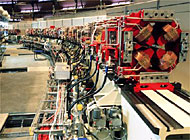Tumour treatment leaves healthy cells unscathed

A pioneering radiation technique, developed in Switzerland to treat deep-seated tumours, is moving out of the laboratory and into hospitals.
The technology, developed at the Paul Scherrer Institute (PSI) in Villigen, targets tumours very precisely causing minimal damage to surrounding healthy tissue.
The success of the technique, which uses protons to target tumours, has prompted worldwide interest and the development of a marketable product for use in hospitals.
A private clinic in Munich, Germany, is installing the machines and is expected to start treating patients in 2006. Other countries including Britain, France and Italy have also expressed interest.
“It’s a good example of the PSI as a laboratory where we will develop the first accelerator and get it running and then transfer that technology into a hospital,” said Tony Lomax, head of the institute’s medical applications team.
Pioneering treatment
Rolf Marti, head of the Swiss Cancer League’s scientific office, told swissinfo the therapy developed at the PSI was a major technological advance.
“It’s really a big step in the treatment of certain cancers… but it’s not [a breakthrough] for all types of the disease,” Marti told swissinfo.
“Take leukaemia for example: you cannot treat cancer of the blood using this therapy. You need a solid tumour and have to know precisely where it is.”
Stefan Bodis, a cancer specialist at Aargau’s cantonal hospital and an associate professor at Zurich University, agrees that not all cancer sufferers will benefit from the treatment.
“I don’t believe that the proton therapy will be a breakthrough for the common cancers, but it is a breakthrough… for tumours which need to be targeted with a very focused approach,” said Bodis.
The aim of radiation therapy is the destruction of cancer tissue by means of charged particles such as protons.
If a proton passes through a cell or comes to rest in it, the cell nucleus is damaged by the energy which the proton deposits.
The challenge of radiation therapy is to administer a strong enough dose to kill the tumour cells while at the same time avoiding damage to healthy tissue.
Experience has shown that it is important not only how much energy is deposited in the cells but how it is deposited.
Eye tumours
The PSI has successfully used proton therapy to treat tumours of the eye for many years.
Building on that experience, staff developed a new technique known as the spot scanning process for the treatment of deep-seated cancers.
With this method, a beam of protons, five to seven millimetres in diameter, is controlled by computers so that high-dose spots of radiation can be positioned very precisely within a tumour.
“Traditional proton methods don’t have the same control over that dose,” said Lomax.
Some 166 patients have been treated at PSI’s proton therapy facility since 1996, particularly for skin tumours at the base of the skull and in the pelvis and prostate.
In 85 per cent of cases, it has been possible to arrest the growth of the tumour.
Central to the success was the design and building of a special gantry or radiation unit which can be rotated allowing irradiation to be carried out in any direction.
About a further 30 people suffering from tumours will benefit from the new technique this year. Patients attend about 30 sessions over a period of seven weeks.
Proton beams
Because the PSI proton accelerators are used mainly for physics and materials science experiments, the institute is building a new extremely compact proton accelerator, called a cyclotron, just to supply the protons for the proton therapy facilities.
“We decided to build a small accelerator which gives us a beam all year round for our own use,” said radio-oncologist, Gudrun Goitein.
A machine of this kind – just a few metres in diameter – is being installed in the new proton therapy clinic in Munich. It is the first commercial facility of its type in Europe.
The clinic in Munich will have four gantries and is designed to treat about
3,000 to 4,000 patients a year.
The cost of building a facility from scratch with a cyclotron and two or
three gantries is estimated at €30 to 60 million (SFR 50 to 100 million).
swissinfo, Vincent Landon
One in three people in Europe faces the likelihood of suffering from cancer during their lifetime.
In Switzerland, around 28,000 people discover each year that they are suffering from a malignant disease.
70 per cent of these will need radiation therapy during their illness.
At present, only about 45 per cent of all diagnosed tumours can be cured, meaning the person will survive for more than five years without further symptoms.
Radiation therapy is the second most effective form of treatment after surgery for malignant tumours.
A patient was treated with protons for the first time in 1954 in the United States.
The first proton therapy programme in Europe ran between 1957 and 1976 at Uppsala (Sweden).
In the US, the Harvard Cyclotron Laboratory and the Massachusetts General Hospital in Boston started proton therapy in 1961.
About 30,000 patients have been treated with protons at 20 centres worldwide.
Since 1984, PSI has treated more than 4,000 eye tumours with a success rate of more than 90 per cent.

In compliance with the JTI standards
More: SWI swissinfo.ch certified by the Journalism Trust Initiative









You can find an overview of ongoing debates with our journalists here . Please join us!
If you want to start a conversation about a topic raised in this article or want to report factual errors, email us at english@swissinfo.ch.